The first attempts to fly into space took the lives of many astronauts. The photo shows part of the crew in the Apollo cabin simulator, 1967.
“If we were to die, we would like people to come to terms with it. The conquest of outer space is worth the risk. These words were spoken by Virgil Grissom, one of the first American astronauts to be a candidate for a manned flight to the moon. As Tom Wolfe writes in his book " The Best. Cowboys who went into space ":
(...) for America, astronauts became not only symbols of the Cold War clash with Russia, but also symbols of Kennedy's political comeback. They became the pioneers of the reworked version of "new horizons", the president's fearless scouts, his strengths in the race to the moon and weapons for the mighty Integral. Oh no, they were no longer mere testers, absolutely, much less experimental subjects.
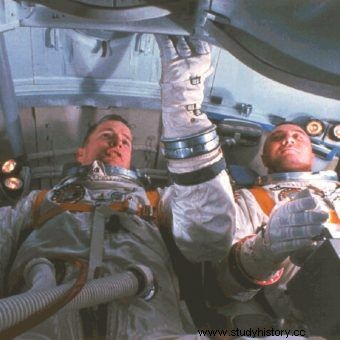
The first attempts to fly into space took the lives of many astronauts. The photo shows part of the crew in the Apollo cabin simulator, 1967.
Even if it were true, man's path into space was littered with the corpses of those who dared to challenge natural limitations and take part in a murderous race to a new frontier. The degree of risk and likelihood of death were considerably, but far higher than in any other area of human progress. Grissom himself has found out about it.
Get us out of here!
On the evening of January 27, 1967, a test of the Apollo ship was carried out at the launch site at NASA's Cape Kennedy, Florida, which was soon to fly into space. The ship was placed at the very top of the Saturn IB carrier rocket, and in its cabin sat a crew of three:Edward H. White, Roger B. Chaffee and Virgil "Gus" Grissom.
During the test, the activities preceding the take-off were practiced. The cabin of the ship was filled with pure oxygen. This was normal procedure as oxygen under reduced pressure reduced Apollo's mass, which in turn allowed more fuel to be taken.
Grissom (who was the commander), White and Chaffee took their places and proceeded to the pre-flight operations. They were not doing well that day. More and more malfunctions appeared, and communication between the ship and the control center was failing. 10 minutes before the end of the exercise, Roger Chaffee said: I'm on fire, I smell . Seconds later, White shouted: Cabin fire! After that, you could still hear Chaffee scream: Get us out of here!
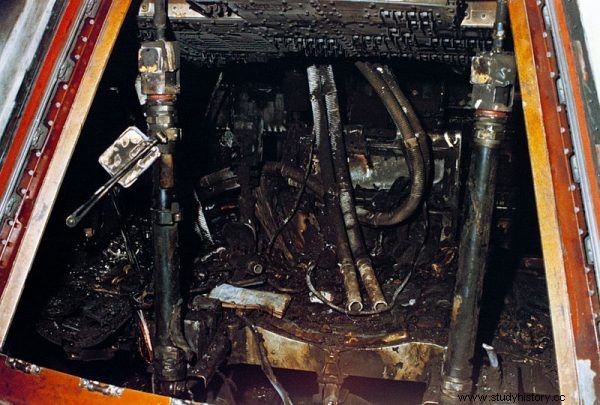
One of the Apollo pre-launch tests cost the life of the ship's three-man crew. The photo shows the charred remains of the interior of the Apollo 1 cabin.
Observers in the center noticed a cloud of white smoke above the ship. The staff rushed to the rescue with the fire extinguishers. After a while, the fire outside Apollo was quenched and technicians began struggling with the locking mechanism of the hatch to the cabin. When they finally opened it, a wave of heat and smoke erupted from inside. Soon the eyes of the team saw the burnt interior and the charred corpses of astronauts sitting in the armchairs ...
Investigation showed that the cause of the fire was a short in the wiring harness in the left-hand side of the cabin in front of Grissom's chair. An electric arc was produced which caused a violent fire in an atmosphere of pure oxygen. Inside, the fire spread rapidly, the temperature rose to 760 degrees Celsius, and tremendous pressure in three places broke the cabin. Astronauts who unsuccessfully tried to get out of it died from burns and poisoning by toxic gases.
The death of three astronauts did not stop the preparations for the flight to the moon. The Apollo program had to be realized. This is what President John F. Kennedy said about it, whose words are quoted by Tom Wolfe in the book " The Best. Cowboys who went into space ":
I think the nation should do its best to make more by the end of this decade man could have stood on Moon and return safe to Earth. At that time, no other the space program will not make a big impression on humanity nor will it be more important to far-reaching research outer space. And none will be a program equally difficult and equally costly.
The only thing that was done after the tragic accident was the modification of Apollo's cabin. The blast hatch has been added, the routing and insulation of electric wires and the composition of the atmosphere have been changed.
The parachutes have failed
A few months after the tragic event, the Soviet ship Soyuz 1 crashed. It took off into space on April 23, 1967 with a one-man crew in the form of Col. Eng. Vladimir Komarov. Soyuz 1 was to connect in space with Soyuz 2, and the entire operation was planned as another great success of Soviet technology. However, the vehicle suffered from breakdowns from the very beginning.
First one of the solar panels broke down, leaving not enough energy to run most of the systems. Then the orientation system sensor, cooling, altimeter, stabilizing system stopped working ... In such a situation, the second Soyuz's launch was canceled, and Komarov was ordered to return.
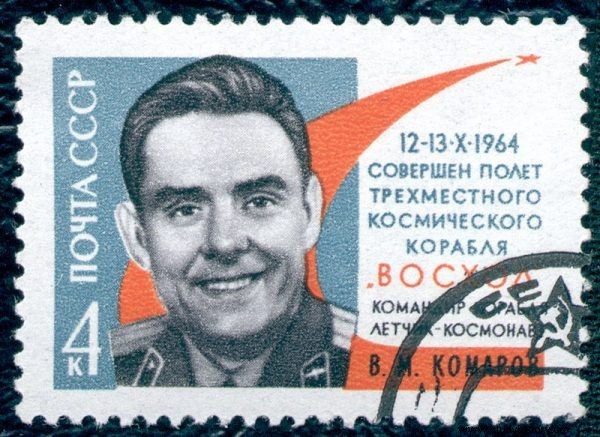
A few months after the death of the Apollo 1 crew, the Russians experienced their own space tragedy. The first in a series of USSR space missions called Soyuz ended in a catastrophe in which Vladimir Komarov was killed. The illustration shows a postage stamp commemorating the cosmonaut.
During the nineteenth orbit of the Earth, the Soyuz lander with the cosmonaut in its center separated from the ship and began to descend from orbit. At an altitude of seven kilometers, a small pilot parachute was thrown, followed by a braking parachute. However, he did not manage to pull out the large main parachute. The cabin whirled. The backup parachute fired, but it got tangled in the brake lines…
The Soyuz lander, dragging its tangled bowls behind it, hit the ground at a speed of 644 kilometers per hour and was crushed. The impact caused the brake rockets to explode, so the fire burned the wreckage. Komarov died on the spot . The urn with his ashes was placed in the Kremlin wall. American astronauts sent a message of condolence to Moscow. "Komarov was one of us," they wrote.
Astronauts without spacesuits
On June 6, 1971, the Soyuz 11 ship with a crew of three:Gierogij Dobrowolski (commander), Wiktor Pacajew and Władisław Wołkow was launched from the Bajkonur cosmodrome. Soyuz arrived at the Salyut 1 space station, and cosmonauts spent 22 days there, setting a record for staying in space. On June 29, the team completed the mission, entered the ship and detached from the station. The Soyuz approached Earth and began the landing maneuver.
At. 1.35 (it was already June 30) the commander turned on the brake motor, then the ship split into parts and the lander began to descend. More parachutes unfolded at the right moment, the automaton shot off the shield of the heat shield, and the lander calmly touched the ground. When the welcoming team reached the capsule and opened the hatch, it saw the cosmonauts sitting in the armchairs. They were all dead .
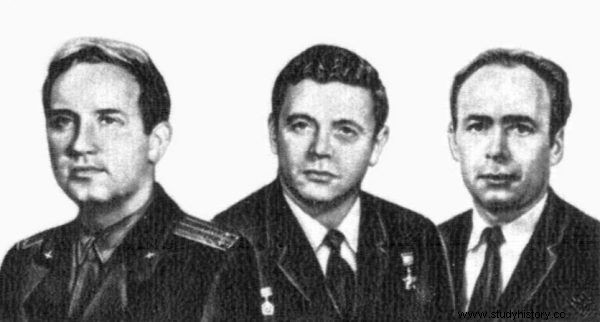
The spacecraft, with the astronauts Volkov, Dobrowolski and Pacajew on board, the Russians launched from the Kazakh Bajkonur cosmodrome on June 6, 1971. During their return to Earth on June 29, 1971, all three crew members died.
What was the cause of death? Research has shown that the cabin was depressurized at an altitude of 100-120 kilometers above the Earth. When separating the cabin from the Soyuz, one of the valves exiting to the outside was damaged (a small ball popped out). The valve has opened to equalize the pressure between the gas mixture filling the cabin and the surroundings. But it should only happen 5 kilometers above the Earth.
The decompression made the cosmonauts suffocate. It also caused an expansion of gases in the gastrointestinal system, an increase in blood pressure, and finally a boiling of fluids in the body . The crew's death was also caused by the fact that the crew members ... were not wearing suits, only plain coveralls. There was not enough space in the cabin to accommodate three people in thick specialized space clothing ... After the accident, the valves were re-constructed and the use of suits was ordered.
Death in front of the audience
On January 28, 1986, the space shuttle Challenger was to take off from the Florida Space Center for the next mission. This would be the tenth extraterrestrial flight of this new machine, flown only three years earlier. In the center, the seat was taken by a crew of seven, commanded by 47-year-old military pilot Francis Scobee. There were also 37-year-old Judith Resnick, the second American astronaut, and Christa McAuliffe, a teacher selected from among 11,000 volunteers for the flight. On board the Challenger, she was supposed to conduct lessons for the students.
The night of January 27-28 was exceptionally cold in Florida. The temperature dropped to minus 4.4 degrees Celsius, an icy wind was blowing. The shuttle placed on the launch site, connected to a large fuel tank and two side rockets, was covered with a layer of ice.
Before the start, the technical team worked hard to remove it. At around 11.38 a.m. on January 28, the main Challenger engines were started, followed by the firing of the booster rockets. The rocket, fifteen-story high, broke from the ground and started slowly upward. The audience gathered in the spectator area began to cheer and cheer. Millions of people watched the departure of the ferry on their TV screens.
Less than a second after take-off, black smoke appeared at the joint of the right booster rocket, followed by fire. With every hundredth of a second the flame grew bigger and bigger. High temperature and flight-related overloads weakened the rocket's lower mount and pulled it away from the main tank. It folded over and hit the tank causing a fuel leak. In the place of its impact, a powerful explosion took place. A huge fireball appeared around the ship as it was flying at a speed of 3,000 kilometers per hour, and the entire team broke into pieces. Smaller and larger fragments scattered in different directions, trailing white plumes of smoke behind them. The television broadcasting the launch showed the terrified faces of the viewers gathered at Cape Canaveral ...
Interestingly, the crew cabin survived the explosion. It rose for another 25 seconds, reaching a height of 19 kilometers and dragging a bundle of electrical cables behind it. Then it fell down and after 2 minutes and 45 seconds it hit the surface of the ocean, completely disintegrating . Seven astronauts died only when the cabin collided with water. It took a lot of time and effort to find the corpses of all crew members (or rather, their fragments). The remains of one of them, Greg Jarvis, were not discovered until April 20.
What was the cause of the disaster? Due to the low temperature, the seal between the segments of the right rocket failed, and the leak released fire from the fuel burning inside.
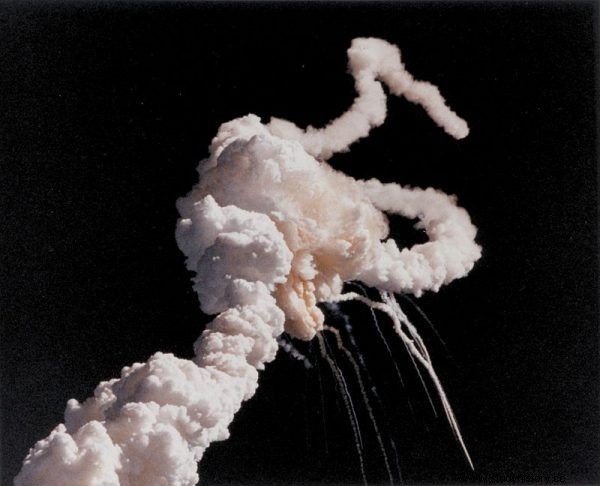
1986 Challenger explosion right after take-off. Although the crew survived the blast, they subsequently died as a result of the machine collapsing and hitting the surface of the ocean.
Piece of foam
On February 1, 2003, another American shuttle, Columbia, suffered a tragic fate. He was returning from a two-week mission in space, during which the crew performed medical and biological experiments. At 2:44 pm the ferry entered the atmosphere. The air traffic control center at the Kennedy Space Center noted disturbing signals:sensors indicated a malfunction in the left wing, then a loss of pressure in both tires attached to it. Around At 3 p.m., observers in Texas noticed that the ferry's trail in the sky was breaking into smaller and smaller pieces. A few minutes later, pieces of the shuttle of various sizes began to fall to the ground:twisted and burnt parts of the hull, tanks, ceramic plates from the cover. Human remains were also falling. All this over an area of several hundred kilometers.
The entire crew of seven, two women and five men perished, including the first Israeli in space, Colonel Ilan Ramon. At. At 3 p.m. the left wing broke away from the shuttle, and a moment later the shuttle broke up. As with the Challenger, the crew cabin survived. However, as soon as air began to escape from it, the crew quickly lost consciousness. Nobody had time to close their helmets and put on gloves. Only a few seconds later the vital functions of the astronauts ceased…
The research showed that the cause of the disintegration of the shuttle was damage to the heat shield on the edge of the left wing. During the Columbia launch on January 16, a piece of casing foam fell off the outer tank. He struck the left wing and punched a hole 25 centimeters in diameter. When the ferry returned to Earth two weeks later, hot gases melted the skin there and began to seep in, destroying the interior. The shuttle lost its steerability and the aerodynamic forces torn it apart.
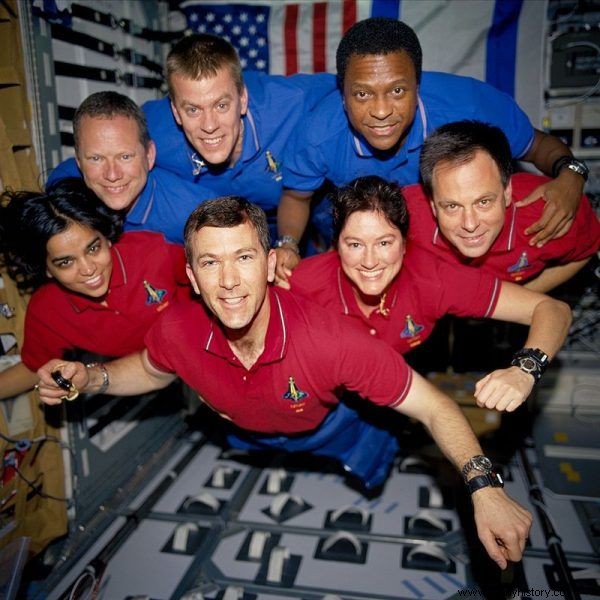
The crew of the American shuttle Columbia in orbit. None of them thought that she would not come back from the mission alive.
The "race for space domination" became the test of death, a prophecy concerning the entire Cold War conflict between the two "superpowers":the Soviet Union and the United States. Public opinion polls showed that, in the opinion of almost all people, the competition in placing space objects into orbit had such an effect that they saw it as a preliminary struggle to prove that a given power had the ultimate and invincible power of destruction - writes Tom Wolfe in the book " The best. Cowboys who went into space ”.
And as it turned out, both powers had this "power of destruction" at their disposal. Only when the public meant first of all the possibility of launching nuclear warheads into orbit, and therefore the prospect of a global threat, it turned out that the destruction first affected individual human beings.
Bibliography:
- Jarosiński Marek, A Scream in space , Scientific and Technical Publishing House, Warsaw 1991.
- Kanawka Krzysztof, Ten years after the Columbia disaster , [accessed on June 13, 2018].
- Wolfe Tom, The best. Cowboys who went into space , Agora, Warsaw 2018.
